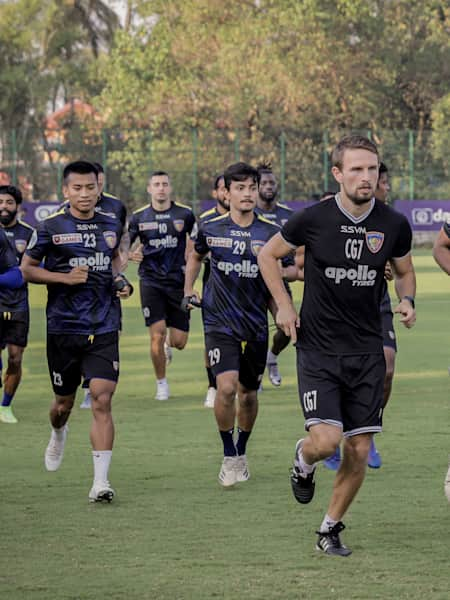Elite sport today is pushing the boundaries of physical limits, and football is no different.
Though the beautiful game is still slave to skill and technique, they are not the only aspects that decide the game anymore. Players need to make sure they last the full 90 minutes without a massive drop in energy and intensity.
“A reasonable level of endurance, or aero capacity is essential for all field-based sports,” says Csaba Gabris, the sports scientist with Chennaiyin FC.
“Endurance is important to help players recover faster between games, difficult training sessions, or – if you talk specifically about match situations – then these high-intensity exchanges during the game.”
Gabris and Chennaiyin FC player Lallianzuala Chhangte chart out some drills and exercises to help you build endurance for football.
Build a base with running
Running is a good place to start. Get those feet moving and your heart pumping.
The goal is to improve cardio capacity, ie your body’s ability to process oxygen so you don’t tire out quickly. Start small and increase the workload every day, every week. Run faster or farther or both.
It’s a basic exercise that is accessible to almost everyone, everywhere.
To make sure he maintained a base level of fitness, Chhangte resorted to it during the lockdown.
“I used to run around 10-15 kilometres every day,” says the 23-year-old winger. “That builds a lot of stamina. Sometimes I would add uphill running to it, or do the distance on the cycle.”
Gabris says that he prescribes running-based fitness drills for players in the off-season and beginning of pre-season.
“In the beginning we do higher volume (longer) and less intense sessions,” says the Slovak. “More fartlek exercises or continuous running-based exercises.”
Fartlek training is a form of interval training, but it is less intense and more flexible when it comes to recovery times.
Do interval training
Even though football players cover about 10 kilometres on an average in each game, it is not at the same pace throughout the match. Rather, it is a combination of sprints, moderate runs, walking and backpedalling.
According to a FIFA study done during the 2018 World Cup, German, English and Spanish players covered an average of 11,400 metres every game. The breakdown of runs is as follows:
- Sprints (more than 24kph): 220m
- High-speed run (21-24kph): 330m
- Moderate run (19-21kph): 550m
- Jogging (11-19kph): 3300m
- Trot, walk, backwards (less than 11kph): 7000m
Interval training helps mimic this to a certain extent.
“Start with 3 cardio sessions, maybe 40 minutes long,” says Gabris. “Week by week we reduce the volume, increase the intensity. Until you come to interval kind of training. That may be something like 100m in 20seconds, then 50 seconds rest and repeat.”
You can also sprint the length of the pitch. Using the same ‘progressive overload’ principle as with increasing cardio capacity, add more sprints and decrease the recovery time between sprints.
Use props like speed ladders, cones and boundary poles
Props like speed ladders, cones or poles are more functional and will help with agility as well as endurance.
In football, you would very rarely run in a straight line; players are constantly changing speed and direction while dribbling the ball.
“As a winger you do a lot of fast moving forward, backward,” says Chhangte.
A typical shuttle run would involve placing five cones five metres apart. Beginning at one end of the cones, run to the second cone and back to the first, then to the third and back to the first. You can add more cones or alter the distance between them. It can also be done by placing cones on four corners of a grid.
Boundary poles are also increasingly used for training in football. These poles can be placed in a straight line and a fixed distance from each other. Slalom around them with or without the ball to build agility and endurance.
Do compound exercises with lower weights and higher reps
“Strength or power is on one side of the abilities and endurance is on the totally opposite side,” says Gabris. “But somehow it’s important to have a certain level of strength. Also lets say have more economic running during endurance exercises.”
The key is to build lean muscle.
“If you are a footballer, you cannot build muscles like a bodybuilder: today is leg day, tomorrow is chest day,” says Chhangte. “Doesn’t work like that. For us, we have concentrate on compound movements: legs, back, chest, everything. When we have a gym session we do everything.”
To build cardio fitness with weight training, Gabris suggests, lower the load and increase the number of repetitions.
“Mostly they will be complex exercises. Sometimes, if the players can even perform weightlifting exercises with less load or higher reps, with proper technique, it’s very good,” says Gabris.
Unlike isolated movements like bicep curls, compound strength exercises involve using multiple muscle groups together. For example, doing a shoulder press while going into a lunge, while maintaining proper form.
Practice with 5v5 games
Five-a-side games are great not only for re-creating match situations but also for building endurance.
“When you play in a tight space you have to move all the time,” says Chhangte. “Run at that speed, go back. Not a lot of time to recover. Usually these are played on a smaller grid, but sometimes we play 5v5 on a big pitch. This helps a lot.”
The intensity is amped up in these games, pushing the players physically and mentally.












